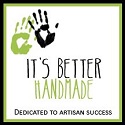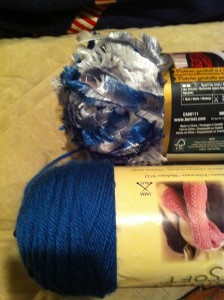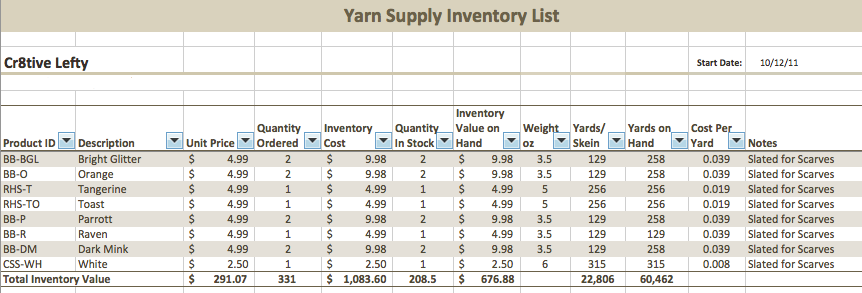Departments
Search
Follow Us
Tags
Latest Highlights
IBH
Handmade Inventory Tracking – Part 1
Supply Inventory Spreadsheet
When we as artists see a design or pattern that we decide inspires us, one of things that come to mind is, “Do I have the supplies to create this?” There are many options for tracking what you have on hand. Some people prefer a manual method and some prefer an automated solution. Either way, keeping good records is essential. I thought I might share the method I use to track my yarn supply.
Like many of you, when I make a yarn purchase, I look for a good price. Sometimes when you find a really good price, you will buy several skeins at one time. When estimating the number of skeins needed it is best to look at the number of yards in a skein verses the ounces. Different brands of yarn will have different thickness and therefore different weight, so ounces alone can be deceiving.
When I started creating a spreadsheet to track my supplies, I recorded basic information, but as time went on I found it helpful to add a few additional columns. This enabled me to see what I had on hand and if I had enough yarn for a given project. There are various spreadsheet applications available.
The following list contains the COLUMNS that I currently use on my spreadsheet, along with a sample of the information captured:
Product ID: CSS-LB ( this is what I use for Caron Simply Soft – Light Blue )
Description: Light Blue (this gives clarity for the last half of the Product ID)
Unit Price: $2.50
Quantity Ordered: 2
Inventory Cost: $5.00 (this is auto calculated ‘Unit Price’ * ‘Quantity Ordered’)
Quantity in Stock: 1
Inventory Value on Hand: $2.50 (this is auto calculated ‘Unit Price’ * ‘Quantity In Stock’)
Weight oz.: 6
Yards per Skein: 315
Yards on Hand: 315 (this is auto calculated ‘Quantity In Stock’ * ‘Yards per Skein’)
Cost per Yard: .008 (this is auto calculated ‘Unit Price’ / ‘Yards per Skein’)
Notes: Slated for scarves
At the bottom of the table I have a row that totals each column and is called Total Inventory Value. This allows me to see the overall picture of what I have purchased, and what I currently have in stock.
Below the totals, I list the Product IDs and their meaning. Since I use various brands of yarn, I have created a naming convention to identify them. The following are some examples:
Summary:
Different businesses require different levels of supply tracking. For example, in this application I can have a separate sheet for different types of supplies, (i.e. sheet1 – yarn, sheet2 – beads/buttons, etc.) and keep them in one workbook. The example I have outlined above can be expanded or simplified.
Tags: artists, Handmade, Handmade Artists, handmade supplies, inventory spreadsheet, inventory tracking, selling tips, small business, supply inventory spreadsheet
Posted in Creative Breakroom, Handmade, Handmade Artisans, Information
17 Responses to “Handmade Inventory Tracking – Part 1”
Leave a Reply
You must be logged in to post a comment.





I read with interest your tracking method of inventory of supplies. And I think I’ll give it a try only on a smaller scale. I currently have a very involved inventory tracking method of all my products complete with individual catalog numbers on each item. I am able to track any item I carry just by knowing the number assigned to it. It works for me. But I think I do need to start an inventory listing of my supplies also, now that you’ve made me think!!!!! Thanks so much!
LOL … it sounds like you have a great product inventory model to work from so hopefully it won’t be too much work 🙂
Nice article! I love that you’ve set it up to do all the math for you!
Great article.
Wonderful article:) This could work with any materials great info!
Great Article. I will share this on my blog.
Oh tis true, tis true. Before I start a project, I have to know what supplies I will be using, and do I have them. Debora does our beading, I add the clasps and metal work. As an example, she prefers that I use lobster claw clasps. She made a necklace last night on gold colored wire, I have no gold/brass lobster claws in stock since she has made so many on gold colored wire this month. So now I know that I will have to fabricate a clasp from wire and sheet metal for this one. I am so happy to see and read your blog.
This is a good idea, and adaptable to just about any kind of inventory. I think it just depends on how you divide things up. When I first read it, I thought, oh this would never work for doll clothes. Thinking of the different types of fabric, laces, elastics, buttons etc. But if I split fabric into wovens, knits, or glittery it would work. Or into those categories plus color. So, in these short minutes (lol) I’ve figured out how adaptable it would be. I think the hard part (for me) is keeping up with it! 🙂 Thanks for sharing!!
I had similar thoughts when I was doing it. The only way I can manage it is to make note of the supplies used when creating a project as I go. Once completed, I update my supply inventory when I post the item to my HA shop and my website. Making it part of my process is the only way I can stay on top of it 🙂
Back when I sold products I didn’t keep track of my supplies that well but I did track the inventory. This goes to show you that even though you are enjoying your work – hobby – you need to treat it as a business. This means tracking all costs and inventory.
[…] little ways back I wrote a posting entitled, “Handmade Inventory Tracking – Part 1“. The focus was on tracking your supplies. For part 2, I wanted to focus on tracking the […]
[…] little ways back I wrote a posting entitled, “Handmade Inventory Tracking-Part 1“. The focus was on tracking your supplies. For part 2, I wanted to focus on tracking the […]
Thanks you so much for posting my article!! I will be reading up on your site and definitely posting your badge on my “Links” page on my website cr8tivelefty.com
[…] little ways back I wrote a posting entitled, “Handmade Inventory Tracking-Part 1“. The focus was on tracking your supplies. For part 2, I wanted to focus on tracking the […]
Thanks you so much for posting my article!! I will be reading up on your site and definitely posting your badge on my “Links” page on my website cr8tivelefty.com
[…] on the financial front, you will need to keep books for your own benefit and to be able to fill in your tax documents at the end of the year and pay […]
[…] on the financial front, you will need to keep books for your own benefit and to be able to fill in your tax documents at the end of the year and pay […]